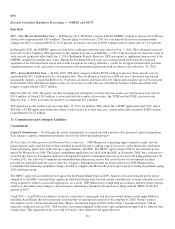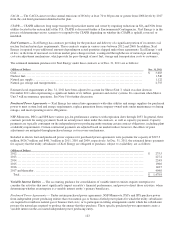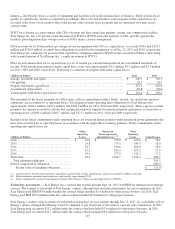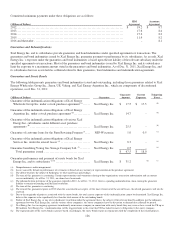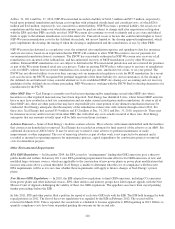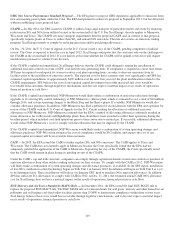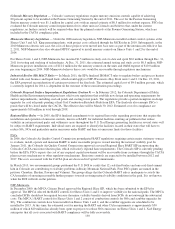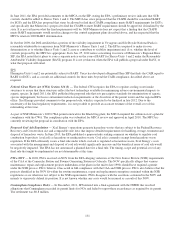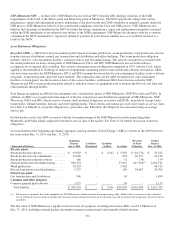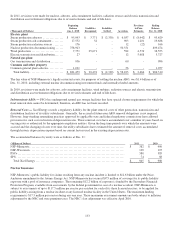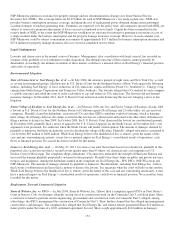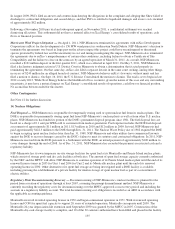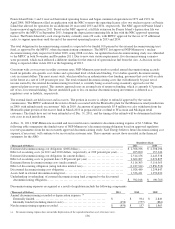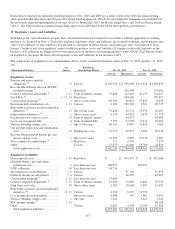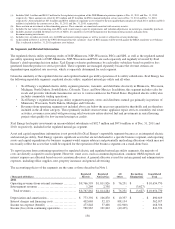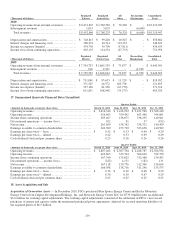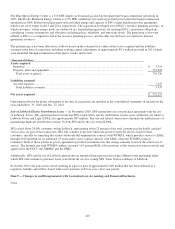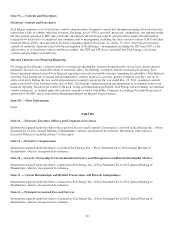Xcel Energy 2011 Annual Report Download - page 141
Download and view the complete annual report
Please find page 141 of the 2011 Xcel Energy annual report below. You can navigate through the pages in the report by either clicking on the pages listed below, or by using the keyword search tool below to find specific information within the annual report.
131
In June 2011, the EPA provided comments to the MPCA on the SIP, stating the EPA’s preliminary review indicates that SCR
controls should be added to Sherco Units 1 and 2. The MPCA has since proposed that the CSAPR should be considered BART
for EGUs and the EPA has proposed that states be allowed to find that CSAPR compliance meets BART requirements for EGUs,
and specifically that Minnesota’s proposal to find the CSAPR to meet BART requirements should be approved, if finalized by the
state. It is not yet known what the final requirements will be. NSP-Minnesota does not expect that a finding that the CSAPR
meets BART requirements would result in changes to the control equipment plans described above, and has requested that the
MPCA retain its 2009 BART determination.
In October 2009, the DOI certified that a portion of the visibility impairment in Voyageurs and Isle Royale National Parks is
reasonably attributable to emissions from NSP-Minnesota’s Sherco Units 1 and 2. The EPA is required to make its own
determination as to whether Sherco Units 1 and 2 cause or contribute to visibility impairment and, if so, whether the level of
controls proposed by the MPCA is appropriate. In its Jan. 25, 2012 notice concerning its review of Minnesota’s Regional Haze
SIP, the EPA noted that it plans to issue a separate notice on the issue of BART for Sherco Units 1 and 2 under the Reasonably
Attributable Visibility Impairment (RAVI) program. It is not yet known when the EPA will publish a proposal under RAVI, or
what that proposal will entail.
SPS
Harrington Units 1 and 2 are potentially subject to BART. Texas has developed a Regional Haze SIP that finds the CAIR equal to
BART for EGUs, and as a result, no additional controls for these units beyond the CAIR compliance, described above are
required.
Federal Clean Water Act (CWA) Section 316 (b) — The federal CWA requires the EPA to regulate cooling water intake
structures to assure that these structures reflect the best technology available for minimizing adverse environmental impacts to
aquatic species. In April 2011, the EPA published the proposed rule that sets prescriptive standards for minimization of aquatic
species impingement, but leaves entrainment reduction requirements at the discretion of the permit writer and the regional EPA
office. Xcel Energy provided comments to the proposed rule, which is expected to be finalized in late 2012. Due to the
uncertainty of the final regulatory requirements, it is not possible to provide an accurate estimate of the overall cost of this
rulemaking at this time.
As part of NSP-Minnesota’s 2009 CWA permit renewal for the Black Dog plant, the MPCA required the submission of a plan for
compliance with the CWA. The compliance plan was submitted for MPCA review and approval in April 2010. The MPCA is
currently reviewing the proposal in consultation with the EPA.
Proposed Coal Ash Regulation — Xcel Energy’s operations generate hazardous wastes that are subject to the Federal Resource
Recovery and Conservation Act and comparable state laws that impose detailed requirements for handling, storage, treatment and
disposal of hazardous waste. In June 2010, the EPA published a proposed rule seeking comment on whether to regulate coal
combustion byproducts (coal ash) as hazardous or nonhazardous waste. Coal ash is currently exempt from hazardous waste
regulation. If the EPA ultimately issues a final rule under which coal ash is regulated as hazardous waste, Xcel Energy’s costs
associated with the management and disposal of coal ash would significantly increase and the beneficial reuse of coal ash would
be negatively impacted. The EPA has not announced a planned date for a final rule. The timing, scope and potential cost of any
final rule that might be implemented are not determinable at this time.
PSCo NOV — In 2002, PSCo received an NOV from the EPA alleging violations of the New Source Review (NSR) requirements
of the CAA at the Comanche Station and Pawnee Generating Station in Colorado. The NOV specifically alleges that various
maintenance, repair and replacement projects undertaken at the plants in the mid to late 1990s should have required a permit
under the NSR process. PSCo believes it has acted in full compliance with the CAA and NSR process. PSCo also believes that the
projects identified in the NOV fit within the routine maintenance, repair and replacement exemption contained within the NSR
regulations or are otherwise not subject to the NSR requirements. PSCo disagrees with the assertions contained in the NOV and
intends to vigorously defend its position. It is not known whether any costs would be incurred as a result of this NOV.
Cunningham Compliance Order — In December, 2011, SPS entered into a final agreement with the NMED that resolved
allegations that Cunningham exceeded its permit limits for NOx and failed to report these exceedances as required by its permit.
The settlement was $0.8 million.



